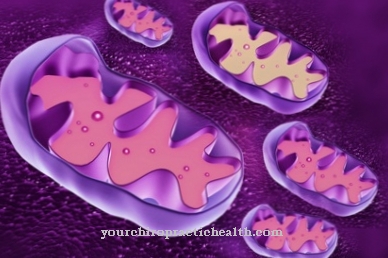Neurons are organized in a network-like structure in the human organism. In it they are about that neurophysiological convergence interconnected. A neuron receives inputs from various other neurons and sums these inputs up. Brain damage with disorders of neural connectivity disrupt this principle of convergence.
What is neurophysiological convergence?

In neurophysiology, convergence corresponds to the merging of neuronal excitation lines. Every neural network consists of a certain number of neurons that are linked together. In the nervous system they functionally form a unit. The circuit of the neurons has several inputs and only has a single output at the same time.
The neuron only generates an action potential when the sum of the input signals exceeds a threshold value. This action potential arises in the initial element on the axon hill of the nerve cell and travels along the respective axon. An action potential or a series of action potentials corresponds to the primary output signal of every neural communication. The action potentials in transmitter quanta are only implemented at biochemical synapses and then correspond to secondary signals.
The merging of several neuronal excitation inputs into a single output corresponds to neurophysiological convergence. It only enables the excitations to be added up above the predefined threshold value, which creates an action potential. Often in connection with the circuit technology of the brain also of Connectivity the speech. In the broadest sense, convergence means that different signals from different neurons can be fed to a neuron via its dendrites.
The term convergence is also used in ophthalmology.
Function & task
Neurons are the individual electrical elements of the human organism. Like the individual components in electrical engineering, the electrical components in the human organism must also be precisely interconnected in order to function and conduct. The connectivity of the neurons enables neurophysiological convergence.
The nervous system of all living things contains not only nerve cells but also glial cells and has a specific environment. There are connecting synapses between the neurons. These synapses correspond to the connection point and thus the nodes in the interneuronal network. However, the neurons are also connected to the glial cells and exchange chemically and electrically with them. This exchange changes the weighting of the signals. For this reason, the glial cells are sometimes referred to as the managers and organizers of the central nervous system.
Many inputs of the neurons are connected to a single output. In neurophysiological convergence, the input signals of the individual inputs add up to a threshold value, which allows the neuron to send an action potential or a series of action potentials on its journey from its one output.
The connectivity leads to neurophysiological convergence and this convergence in turn gives rise to the primary output signals of the nervous system. The axons of the neurons are strongly branched. In this way, the signal from a single neuron is transmitted to many other neurons. This relationship is also called neurophysiological divergence. At the same time, the neuron receives the signals from many other neurons via the dendrites and thus works with convergence. The principles of divergence and convergence are essential basic principles of the neural network and thus also play a role in the learning ability of the neural networks, for example.
You can find your medication here
➔ Medicines for paresthesia and circulatory disordersIllnesses & ailments
Neural convergence is essentially dependent on the connectivity of the neurons. If the neural network in the brain is damaged, this connectivity and with it the neurophysiological convergence is disturbed. Damage to the neural network can be attributed to different causes. The circuits in the brain and nervous system are extremely precise, which requires a complex and intact structure. Irregularities or malfunctions within the system automatically offset each other to a certain extent. After actual damage to the brain structure, serious disorders occur that can no longer be intercepted. The electrical and biochemical network is losing connectivity. Neurological or psychiatric illnesses are the result.
The location and type of damage determined the disturbances that occur. Since many nerve cell structures are involved in a large number of individual functions thanks to connectivity and convergence, local damage to the neural network can also have extensive consequences with far-reaching clinical symptoms. Sometimes the most common cause of brain damage is poor blood flow. The brain works constantly and for this reason has the greatest energy requirement of the organs. An interruption in the blood supply corresponds to both an interruption in the supply of nutrients and oxygen.
Inadequate blood flow can be attributed, for example, to heart palpitations or hypoglycaemia. Occasionally, however, brain tumors also cause a pathological change in the blood vessels.The same applies to mechanical injuries in accidents, after bleeding in the brain and from inflammation. Disturbances in signal transmission between the nerve cells are often the reason for impaired brain function. In some cases such disorders are preceded by irregularities in the metabolic activity of the nerve cells.
However, brain damage can also result from genetic factors, for example hereditary diseases that impair the metabolism of nerve cells and thus cause certain substances to accumulate in the brain.
External influences such as bacteria, viruses or toxins can also affect the neural network and its circuits. For example, mercury poisoning can cause memory loss or muscle tremors.
However, the patient's immune system is also responsible for many disorders of convergence and divergence. In the autoimmune disease multiple sclerosis, the immune system classifies certain cells of the central nervous system as foreign and attacks them. The resulting inflammation partially destroys the connectivity on which convergence is based.













.jpg)

.jpg)
.jpg)











.jpg)